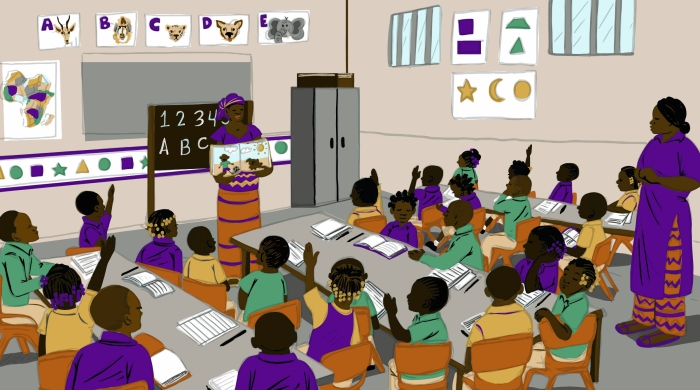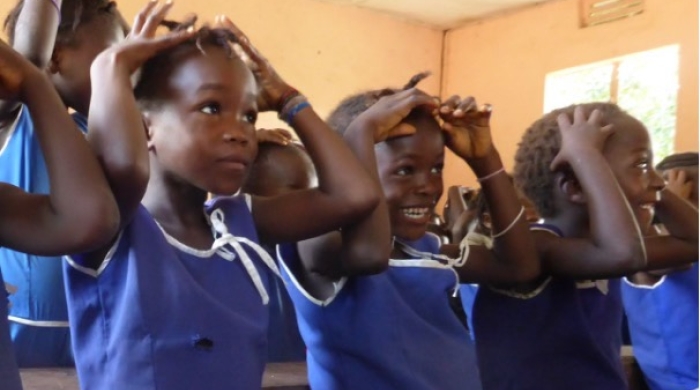Written by Douha Boulares and Kalina Gjicali, Global TIES for Children
While nearly 1 billion children were out of school worldwide in 2020 due to the COVID-19 pandemic, the lack of access to education was most pronounced among children in low- and middle-income countries and humanitarian contexts. A recent report by the World Bank, UNESCO, and UNICEF, for example, finds that children in low- and middle-income countries were the least likely to both access remote learning opportunities and to be monitored on their learning loss. Information on how much children have learned - and where they still need to improve - is critical in order to ensure that remedial and accelerated “catch-up” learning opportunities are targeted to the right level.
A new research-practice partnership, brokered by Porticus, brought together NYU Global TIES for Children (NYU-TIES), War Child Holland, and UNHCR’s Humanitarian Education Accelerator (HEA) to develop an effective tool to measure holistic learning outcomes across distance education and digital learning interventions in humanitarian settings. The partnership was formed in response to a clear gap in the area of education and tech-driven programs in humanitarian settings, and by a need to connect these two sectors to support continued learning during school closures. Through a process of co-creation that draws upon the valuable skills and experience of each organization - in gamified learning, learning measurement and innovation for refugee education - the research-practice partnership team is working together to develop, test and pilot a gamified learning assessment tool that has the potential to measure both academic and social and emotional learning (SEL) skills.
Our NYU-TIES team was specifically approached to work on the project due to their expertise in measurement and evaluation, serving as advisors on the development of a tool to help teachers assess children’s learning through digital technologies, either at home or in the classroom. This novel approach to assessment can support learners while generating usable data for teachers to inform their instruction.
NYU-TIES is sharing prior research findings and expertise around student academic and SEL assessment through game-based technology. One priority for this project is to ensure that relevant (rather than distracting) gaming features are embedded into the assessment and that the content being developed is appropriately meeting the goals of a formative assessment. The goal is to ensure that the features of the game, the assessment items, and the interaction with the interface of the gamified tool produce a valid formative assessment measuring:
- 2 main academic skills: numeracy competence and Arabic literacy for grades 1 through 3
- 2 SEL components: self-efficacy and growth mindset through child self-report.
The purpose of a formative assessment, regardless of whether it is done in in-person in the classroom or through digital tools while at home, is two-fold: (1) to provide formative feedback to students based on their performance and (2) to provide formative information for teachers about student performance in order to adapt teaching.
However, high-quality and effective formative assessment is difficult to implement without the right tools. The biggest benefit of a digital tool is that you can get to know in real time what children know and are able to do. This information can be provided to educators who can review student performance in a number of ways in order to identify which students need support, what they need support in, and what misconceptions about learning are being formed. These snapshots can empower teachers to make prompt adjustments about their instruction to maximize students’ potential. In turn, children can receive real-time individualized feedback when they are engaging with an assessment item, which is a way of delivering individualized instruction, something that is almost impossible to do in real life. “The tool developed for this project is also providing children with messages praising their effort like 'The more you try, the more you learn!’” says Kalina Gjicali, Research Scientist at NYU Global TIES for Children. Research shows that these positive praise messages build children’s positive self- efficacy for learning.
Want to learn more? Read HEA’s blog on the subject.
Learn More
Global TIES for Children
Global TIES for Children is an international research center at New York University dedicated to designing, evaluating and advising on programs and policies to improve the lives of children and youth in the most vulnerable regions across the globe.
Can Tutoring Informed by Social-Emotional Principles Improve Learning Outcomes?
Global TIES for Children works collaboratively with the International Rescue Committee to explore what can be done to improve learning outcomes for the millions of children growing up in conflict-affected societies and enrolled in under-resourced school systems.
Realizing the Promise
In this Q&A with On the Ground, Dr. Alejandro Ganimian discusses his recent Brookings report on education technology, or "ed tech," and the major findings of his research.




